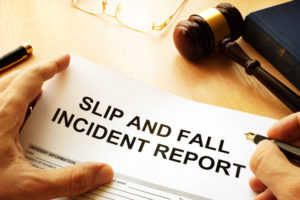Calculating Damages After Being Injured in a Fall

When you have a slip and fall case, you need to make informed decisions. One of the most important decisions you may need to make is deciding when (and if) to settle your case. Knowing whether to accept a settlement offer starts with understanding how much you are entitled to recover.
When you have a slip and fall case (or any type of personal injury case) in Florida, your losses are referred to as your “damages.” Damages fall into two broad categories: financial and non-financial.
Financial damages are those that impact your bank account. This could either mean that money is going out (i.e., you are paying medical bills) or that money isn’t coming in (i.e., if you are unable to work). Your financial damages also include any debt you incur as a result of your injuries, as well as the financial losses you are likely to incur in the future.
Non-financial damages are those that impact your life in other ways. Even if you don’t realize it now, your injuries could impact your life for years to come. Emotional trauma, pain and suffering, loss of consortium and companionship, and loss of enjoyment of life are all common examples of non-financial damages in slip and fall accident cases.
Calculating Financial Damages After a Slip and Fall Accident
So, how do you calculate your damages? We’ll cover your financial damages first. While calculating your financial damages might seem like it is simply a matter of adding up your receipts and outstanding medical bills, there is actually much more involved.
This is because accident victims who have a slip and fall case in Florida can recover their current and future losses. So, while calculating your financial damages involves adding up your receipts and outstanding medical bills, this is just the beginning of the process. To ensure that you are seeking the full financial damages you deserve, you need to know:
- Your total medical expenses (both paid and unpaid) to date
- Your other out-of-pocket costs to date (i.e., prescriptions, medical supplies and transportation)
- Your lost income and benefits to date
- How much you will need to cover your future medical expenses and other out-of-pocket costs
- How much you will need to cover your future loss of earnings
As a result, calculating your financial damages requires a clear understanding of your long-term prognosis. Will you need surgery? Will you need physical or occupational therapy? How long will you be out of work? When you return to work, will you only be able to work part-time or in a limited capacity? The answers to these questions—among many others—are critical for understanding the value of your claim. When we represent slip and fall accident victims, we work with doctors, financial analysts and other experts to ensure that we are seeking the full financial damages our clients are entitled to recover.
In many cases, slip and fall accident victims’ long-term costs will far exceed their financial losses to date. This makes accurately calculating their future financial damages extremely important. If you settle for too little, you may not have the financial resources you need in the years ahead, and you won’t be able to go back and ask for more.
Calculating Non-Financial Damages
Calculating your non-financial damages after a slip and fall accident involves a different analysis entirely. Rather than focusing on your out-of-pocket costs, this calculation focuses on all of the intangible ways that your injuries impact (and will continue to impact) your day-to-day life.
As a general rule, the more severe and long-term these impacts are (and will be), the more non-financial damages you can recover. But, there are no set dollar amounts or mathematical formulas that apply. Instead, courts and insurance companies in Florida generally use one of two methods to calculate accident victims’ non-financial damages in slip and fall cases:
- The Per Diem Method – This method involves calculating a daily compensation rate for your emotional trauma, pain and suffering, and other non-financial losses. This daily compensation rate (or per diem) is then multiplied by the total number of days that you will experience the non-financial impacts of your injuries over your lifetime.
- The Multiplier Method – This method requires a clear picture of your financial damages. Once your financial damages have been established, the total dollar amount is then multiplied by a number (usually between 1 and 5) based on the severity and anticipated duration of your non-financial losses.
To maximize the non-financial damages you are able to recover, you will need to document the day-to-day impacts of your injuries as thoroughly as possible. With this in mind, you will want to get in the habit of taking notes on a daily basis. If you record your daily pain levels and document all of the ways your injuries negatively impact your life (i.e., by preventing you from spending time with friends and family), this will go a long way toward helping your lawyer recover the full financial compensation you deserve.
Your lawyer will take several steps to document your non-financial damages as well. These may include obtaining statements from your friends and family members, creating a video that shows how your life has changed, and obtaining reports from psychologists and other experts, among others. While proving your financial and non-financial damages takes time, it is worth it—and, when your case is over, you will be glad that you did everything you could to seek the maximum financial compensation available.
Find Out How Much You May Be Entitled to Recover for Free
If you are wondering how much you can recover after a slip and fall accident in Florida, we invite you to contact us for a free, no-obligation consultation. We represent accident victims and their families statewide. To speak with an experienced lawyer about your legal rights in confidence, give us a call at 800-780-8607 or request a free initial consultation online today.
Share This


